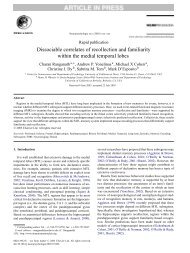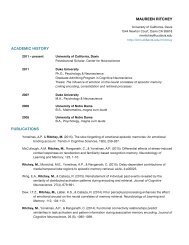CLINICAL EEG and NEUROSCIENCE - Dynamic Memory Lab
CLINICAL EEG and NEUROSCIENCE - Dynamic Memory Lab
CLINICAL EEG and NEUROSCIENCE - Dynamic Memory Lab
You also want an ePaper? Increase the reach of your titles
YUMPU automatically turns print PDFs into web optimized ePapers that Google loves.
<strong>CLINICAL</strong> <strong>EEG</strong> <strong>and</strong> <strong>NEUROSCIENCE</strong> ©2007 VOL. 38 NO. 1For example, Auchterlonie <strong>and</strong> colleagues 3 investigatedwhether anomia in AD was attributable to degradation ofthe semantic store or to an independent word-findingdeficit. In that study, the N400 component-sensitive tosemantic processing load, was equally diminished inresponse to named <strong>and</strong> unnamed pictures, suggesting thatanomia <strong>and</strong> semantic deficits are independent in AD.As sensitive measures of cognitive processes <strong>and</strong> theirdisruption due to neuropathology, ERPs have much potentialclinical utility. For example, ERPs may aid in the earlydiagnosis of neurodegenerative disorders such as AD. Wi t hcareful study design, ERPs may be used to isolate relevantcognitive processes <strong>and</strong> to facilitate differential diagnosis. A sdirect measures of synaptic function, ERPs are also potentiallyuseful in the evaluation of pharmacological treatments.The present work is a selective review of cognitive-ERP studies of memory <strong>and</strong> language impairments inamnesia <strong>and</strong> AD. The amnestic syndrome, typically causedby bilateral lesions of the MTL, is characterized by theinability to encode <strong>and</strong> retrieve episodic memories beyondthe brief duration of working memory. The neuropathologyof AD includes MTL structures early in the course of thedisease, <strong>and</strong> a deficit of episodic memory is one of theearly behavioral hallmarks of the disease. However, neocorticalassociation areas are also affected early in AD, <strong>and</strong>patients may present with semantic memory <strong>and</strong> wordfindingdeficits. Therefore, ERP effects that are dependentupon successful encoding <strong>and</strong> retrieval from episodicmemory are expected to be absent or diminished in bothamnesia <strong>and</strong> AD, whereas ERP effects that index semanticprocessing or other higher cognitive functions (e.g.,attention, response selection) may be selectively diminishedin AD. Intracranial <strong>EEG</strong>/ERP studies of pre-surgicaltemporal lobe epilepsy patients provide clues to the neuralgenerators of scalp-recorded ERP components, <strong>and</strong> someof these studies are discussed here. ERP studies of individualswith mild cognitive impairment (MCI), memorydeficits in the absence of functional decline <strong>and</strong> thereforenot meeting the diagnostic criteria for probable AD, arealso discussed, as they may reveal neurophysiologicalchanges that precede clinical deficits. These studies holdgreat potential for the early detection <strong>and</strong> diagnosis of AD.Through this review, we hope to illustrate several keydifferences in the ERP abnormalities in well-circumscribedamnesia compared to dementias such as AD. To anticipate,while well-circumscribed lesions of the MTL or diencephalonappear to produce altered plasticity of the latepositive P600 component, the P300 <strong>and</strong> N400 are usuallyspared. However, with the widespread neuropathologicalchanges in AD, all three of these components commonlyshow abnormalities.P300: OverviewThe P300 (or “P3b”) component is a scalp positivityelicited by low-probability stimuli during stimulus classificationtasks which peaks ~300 ms post-stimulus, maximal overmidline centroparietal sites. In the canonical P300 experiment,the “auditory oddball” task, participants detect a lowprobability“target” (e.g., high-pitched) tone in a stream of“st<strong>and</strong>ard” (e.g., low-pitched) tones, <strong>and</strong> the typical result isa clear P300 for targets with a relatively flat ERP r e s p o n s ein the same latency range for st<strong>and</strong>ards. The P300 has beenextensively studied <strong>and</strong> well characterized in both normal<strong>and</strong> neurologically impaired populations. P300 latency isvariable <strong>and</strong> generally proportional to the complexity of thestimulus evaluation <strong>and</strong> decisional processes dem<strong>and</strong>ed bythe task. It has been suggested that the P300 reflectsprocesses involved in updating working memory, 4 or theprocesses of stimulus discrimination <strong>and</strong> response selecti o n . 5 H o w e v e r, P300 amplitude <strong>and</strong> latency are modulatedby a variety of factors — subjective probability, stimuluss a l i e n c y, availability of attentional resources 6 — <strong>and</strong> itappears to be generated by a distributed network of neuralregions — inferotemporal, perirhinal, prefrontal, cingulate,superior temporal <strong>and</strong> parietal cortices, as well as the hippo c a m p u s 7 , 8 — suggesting that P300 likely indexes a heterogeneousset of cognitive processes. On the other h<strong>and</strong>,studies of patients with damage to the temporo-parietal junctionhave found that the auditory P300 response is eliminated , 9 suggesting that this neocortical region may be critical ingeneration or propagation of the scalp P300.P300 in amnesiaGiven that working memory <strong>and</strong> response selectionprocesses are not typically disturbed in circumscribed medial-temporalamnesia, one might expect the P300 responseto low-probability stimuli to be intact in this population.H o w e v e r, as noted above, intracranial recordings haveshown that the hippocampus <strong>and</strong> paralimbic cortices areamong the brain regions that produce P300-like responses.It remains unknown to what extent the medial-temporalP300 contributes to the P300 recorded at the scalp.Rugg et al 10 studied the P300 response of a single individualwith amnesia due to an infiltrating glioma in the leftMTL. In both auditory <strong>and</strong> visual oddball experiments,Rugg et al found normal P300 effects in this amnesicpatient. Another report of an individual with amnesia due toa lesion of the left MTL found that the P300 was similarlyintact. 11 Two case studies of bilateral medial temporalpathology also found auditory <strong>and</strong> visual P300s that werecomparable to those in normal controls. 12,13 A group studyof five patients with damage restricted to bilateral MTL dueto various etiologies 14 found no significant differences inauditory or visual P300 amplitude or latency between theamnesic patients <strong>and</strong> controls.Honda et al 15studied a heterogeneous group ofamnesic patients <strong>and</strong> found that the integrity of the auditoryP300 response depended on the extent of MTL damageas detected by structural imaging (MRI, CT). Robust P300responses were found in patients in whom no lesions were9




